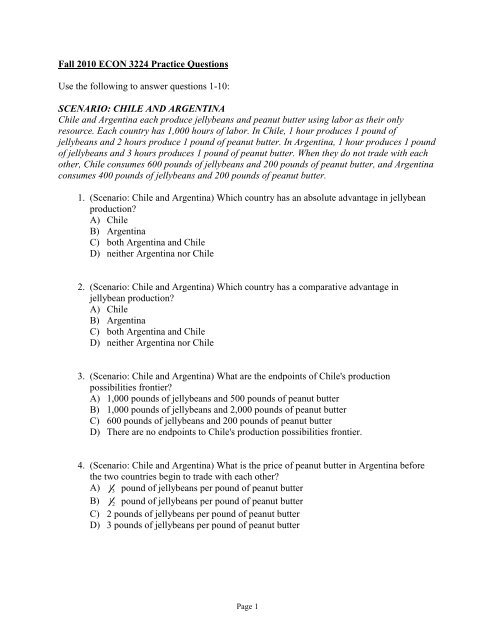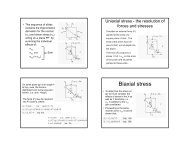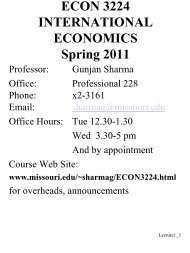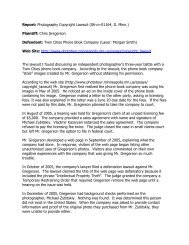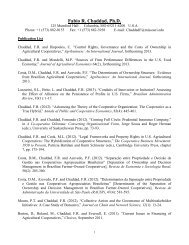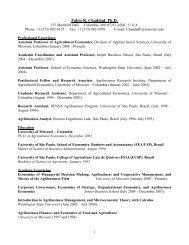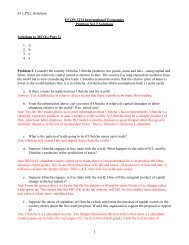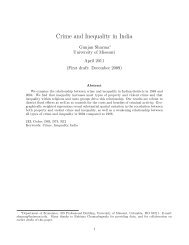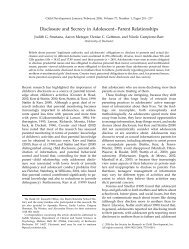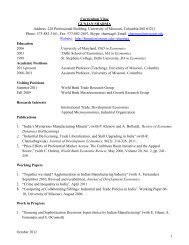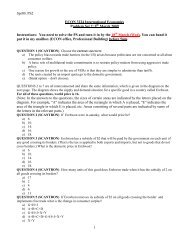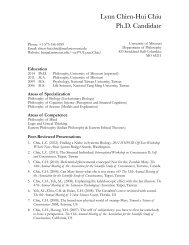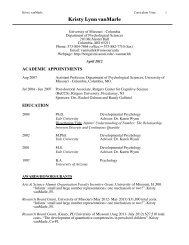Fall 2010 ECON 3224 Practice Questions Use the following to ...
Fall 2010 ECON 3224 Practice Questions Use the following to ...
Fall 2010 ECON 3224 Practice Questions Use the following to ...
You also want an ePaper? Increase the reach of your titles
YUMPU automatically turns print PDFs into web optimized ePapers that Google loves.
<strong>Fall</strong> <strong>2010</strong> <strong>ECON</strong> <strong>3224</strong> <strong>Practice</strong> <strong>Questions</strong><br />
<strong>Use</strong> <strong>the</strong> <strong>following</strong> <strong>to</strong> answer questions 1-10:<br />
SCENARIO: CHILE AND ARGENTINA<br />
Chile and Argentina each produce jellybeans and peanut butter using labor as <strong>the</strong>ir only<br />
resource. Each country has 1,000 hours of labor. In Chile, 1 hour produces 1 pound of<br />
jellybeans and 2 hours produce 1 pound of peanut butter. In Argentina, 1 hour produces 1 pound<br />
of jellybeans and 3 hours produces 1 pound of peanut butter. When <strong>the</strong>y do not trade with each<br />
o<strong>the</strong>r, Chile consumes 600 pounds of jellybeans and 200 pounds of peanut butter, and Argentina<br />
consumes 400 pounds of jellybeans and 200 pounds of peanut butter.<br />
1. (Scenario: Chile and Argentina) Which country has an absolute advantage in jellybean<br />
production?<br />
A) Chile<br />
B) Argentina<br />
C) both Argentina and Chile<br />
D) nei<strong>the</strong>r Argentina nor Chile<br />
2. (Scenario: Chile and Argentina) Which country has a comparative advantage in<br />
jellybean production?<br />
A) Chile<br />
B) Argentina<br />
C) both Argentina and Chile<br />
D) nei<strong>the</strong>r Argentina nor Chile<br />
3. (Scenario: Chile and Argentina) What are <strong>the</strong> endpoints of Chile's production<br />
possibilities frontier?<br />
A) 1,000 pounds of jellybeans and 500 pounds of peanut butter<br />
B) 1,000 pounds of jellybeans and 2,000 pounds of peanut butter<br />
C) 600 pounds of jellybeans and 200 pounds of peanut butter<br />
D) There are no endpoints <strong>to</strong> Chile's production possibilities frontier.<br />
4. (Scenario: Chile and Argentina) What is <strong>the</strong> price of peanut butter in Argentina before<br />
<strong>the</strong> two countries begin <strong>to</strong> trade with each o<strong>the</strong>r?<br />
A) 1 3 pound of jellybeans per pound of peanut butter<br />
B) 1 2 pound of jellybeans per pound of peanut butter<br />
C) 2 pounds of jellybeans per pound of peanut butter<br />
D) 3 pounds of jellybeans per pound of peanut butter<br />
Page 1
5. (Scenario: Chile and Argentina) In order for Chile <strong>to</strong> gain from trade, <strong>the</strong> price of<br />
jellybeans must be less than:<br />
A) 2 pounds of peanut butter per pound of jellybeans.<br />
B) 3 pounds of peanut butter per pound of jellybeans.<br />
C) 0.33 pounds of peanut butter per pound of jellybeans.<br />
D) 0.50 pounds of peanut butter per pound of jellybeans.<br />
6. (Scenario: Chile and Argentina) Argentina's gains from trade will be largest when <strong>the</strong><br />
price of jellybeans is:<br />
A) 2 pounds of peanut butter per pound of jellybeans.<br />
B) 3 pounds of peanut butter per pound of jellybeans.<br />
C) 0.33 pounds of peanut butter per pound of jellybeans.<br />
D) 0.50 pounds of peanut butter per pound of jellybeans.<br />
7. (Scenario: Chile and Argentina) What is <strong>the</strong> opportunity cost of a pound of peanut butter<br />
in Chile?<br />
A) 2 pounds of jellybeans per pound of peanut butter<br />
B) 3 pounds of jellybeans per pound of peanut butter<br />
C) 0.33 pounds of jellybeans per pound of peanut butter<br />
D) 0.50 pounds of jellybeans per pound of peanut butter<br />
8. (Scenario: Chile and Argentina) Now suppose that <strong>the</strong> two countries begin <strong>to</strong> trade with<br />
one ano<strong>the</strong>r. Each completely specializes in <strong>the</strong> product in which it finds its comparative<br />
advantage. How many pounds of peanut butter and jellybeans do <strong>the</strong> two countries<br />
jointly produce?<br />
A) 1,000 pounds of jellybeans and 400 pounds of peanut butter<br />
B) 1,000 pounds of jellybeans and 500 pounds of peanut butter<br />
C) 500 pounds of jellybeans and 1,000 pounds of peanut butter<br />
D) 333.33 pounds of jellybeans and 500 pounds of peanut butter<br />
9. (Scenario: Chile and Argentina) Which group will benefit from trade between Chile and<br />
Argentina?<br />
A) Chilean consumers<br />
B) Argentinean peanut butter producers<br />
C) Argentine consumers<br />
D) Chilean consumers, Argentinean peanut butter producers, and Argentine consumers<br />
Page 2
10. (Scenario: Chile and Argentina) Now suppose that <strong>the</strong> two countries begin <strong>to</strong> trade with<br />
each o<strong>the</strong>r. Each completely specializes in <strong>the</strong> product in which it finds its comparative<br />
advantage. How many more pounds of peanut butter and jellybeans do <strong>the</strong> two countries<br />
jointly produce compared with production before <strong>the</strong>y began <strong>to</strong> trade?<br />
A) 1,000 pounds of jellybeans and 500 pounds of peanut butter<br />
B) 0 pounds of jellybeans and 500 pounds of peanut butter<br />
C) 1,000 pounds of jellybeans and 0 pounds of peanut butter<br />
D) 0 pounds of jelly beans and 100 pounds of peanut butter<br />
<strong>Use</strong> <strong>the</strong> <strong>following</strong> <strong>to</strong> answer questions 11-14:<br />
Table: Production and Prices in Two Industries<br />
11. (Table: Production and Prices in Two Industries) According <strong>to</strong> <strong>the</strong> information provided<br />
in <strong>the</strong> table, <strong>the</strong> wage rate in <strong>the</strong> agriculture sec<strong>to</strong>r is:<br />
A) $50.<br />
B) $15.<br />
C) $30.<br />
D) $10.<br />
12. (Table: Production and Prices in Two Industries) According <strong>to</strong> <strong>the</strong> information provided<br />
in <strong>the</strong> table, <strong>the</strong> wage rate in <strong>the</strong> manufacturing sec<strong>to</strong>r is:<br />
A) $50.<br />
B) $10.<br />
C) $100.<br />
D) $30.<br />
13. (Table: Production and Prices in Two Industries) Using <strong>the</strong> information from <strong>the</strong> table,<br />
we can expect <strong>the</strong> <strong>following</strong> <strong>to</strong> happen in <strong>the</strong> economy:<br />
A) Labor will migrate from <strong>the</strong> agriculture <strong>to</strong> <strong>the</strong> manufacturing sec<strong>to</strong>r.<br />
B) Labor will migrate from <strong>the</strong> manufacturing <strong>to</strong> <strong>the</strong> agriculture sec<strong>to</strong>r.<br />
C) The marginal product of labor in <strong>the</strong> agriculture sec<strong>to</strong>r will increase.<br />
D) The marginal product of labor in <strong>the</strong> manufacturing sec<strong>to</strong>r will decrease.<br />
14. (Table: Production and Prices in Two Industries) According <strong>to</strong> <strong>the</strong> information provided<br />
in <strong>the</strong> table, if <strong>the</strong> price of <strong>the</strong> agriculture good decreases <strong>to</strong> $5, <strong>the</strong>n:<br />
A) Wages in <strong>the</strong> manufacturing sec<strong>to</strong>r will decrease.<br />
B) The wage rate in <strong>the</strong> agriculture sec<strong>to</strong>r will be $25.<br />
C) The marginal product of both sec<strong>to</strong>rs will decline.<br />
D) We should import more agriculture goods.<br />
Page 3


